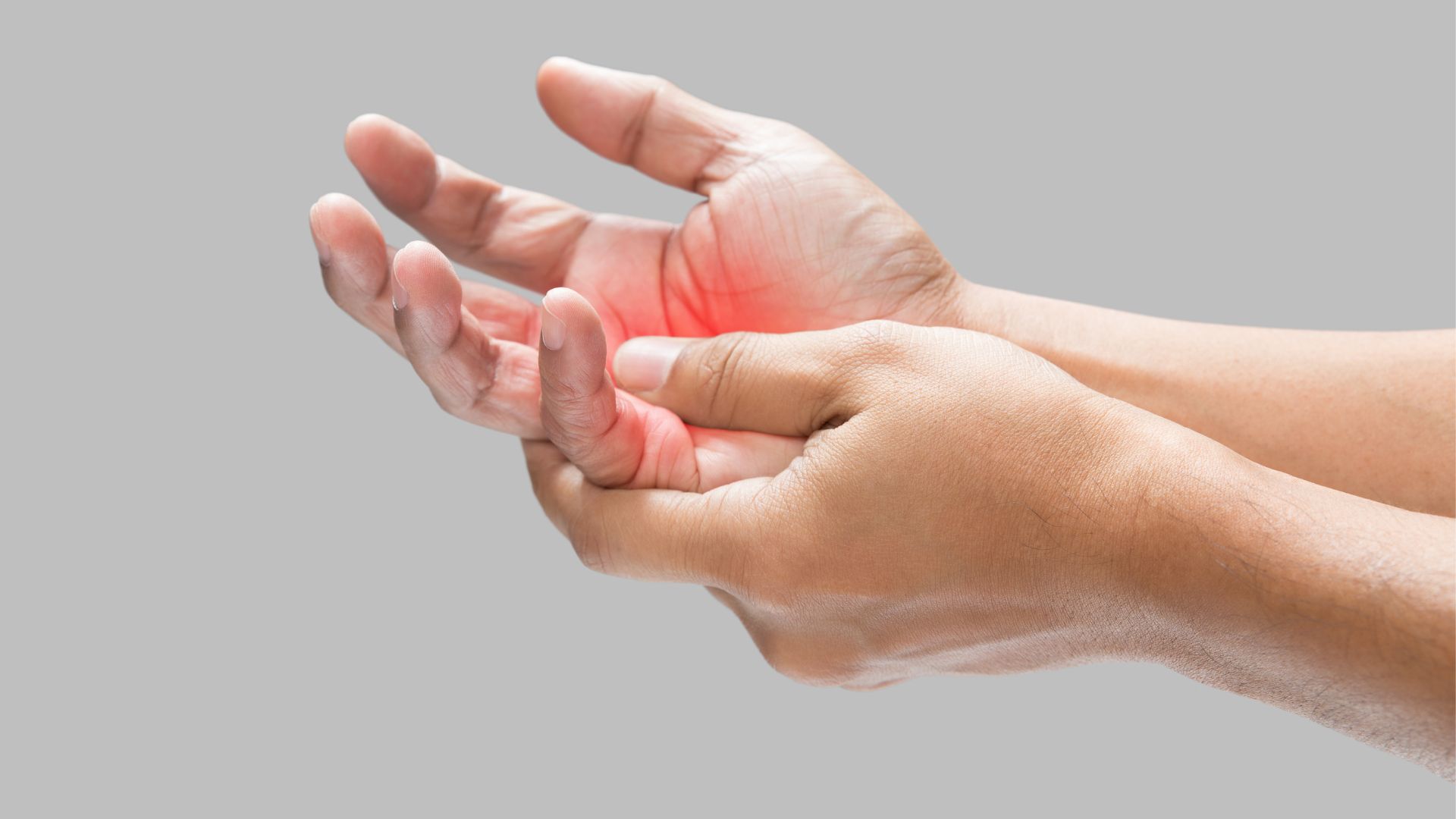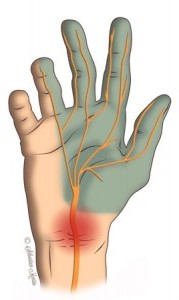Do you often find yourself waking up with a tingling or numb sensation in your hand? It’s a common issue that can disrupt your daily routine and leave you wondering what’s going on.
Imagine the relief of finally understanding why this happens and learning how to address it. You’re not alone in this, and the good news is that you can take steps to regain control. We’ll explore the causes behind that unsettling numbness and reveal practical solutions to help you find comfort and peace of mind.
Stay with us as we unravel the mystery and empower you with knowledge that can transform your daily life.

Credit: www.radixchiro.com
Common Causes Of Hand Numbness
Hand numbness often results from repetitive motions, such as typing or gripping tools. Conditions like carpal tunnel syndrome, diabetes, or a pinched nerve can also cause this sensation. Poor circulation in the hands might be another reason for experiencing numbness.
Experiencing numbness in your hand can be unsettling. It often raises questions about its cause and how to address it. Understanding the common causes can help you take control and find solutions. Let’s explore some of the usual culprits behind that tingling sensation.
Carpal Tunnel Syndrome
Carpal Tunnel Syndrome is a frequent offender. It occurs when the median nerve, running through the wrist, gets compressed. Do you spend long hours typing or using a mouse? You might find yourself at risk. Regular breaks and ergonomic tools can reduce strain and help prevent this condition.
Peripheral Neuropathy
Peripheral Neuropathy is another possible cause. This condition affects the nerves outside the brain and spinal cord. Diabetes is a common trigger, but injuries or infections can also lead to it. If you have persistent numbness, checking with a healthcare provider can be a wise step.
Cervical Radiculopathy
This condition often stems from issues in the neck. A herniated disc or arthritis might pinch nerves, causing numbness that radiates down to your hand. Have you noticed any neck pain accompanying the numbness? Keeping a good posture and performing neck exercises could provide relief.
Ulnar Nerve Entrapment
The ulnar nerve runs through your arm and can become trapped, causing numbness in the ring and little fingers. Often, leaning on your elbows or repetitive elbow movements might trigger this. Adjusting your habits, like avoiding prolonged elbow pressure, can make a big difference. Hand numbness can be more than just an inconvenience. It might signal underlying issues that need attention. By identifying the cause, you can take proactive steps to alleviate the discomfort. Have you recognized any patterns or triggers in your daily routine? Addressing them could be key to regaining comfort and functionality.
Recognizing Symptoms
Numbness in the hand can be a troubling experience. Recognizing symptoms early helps in addressing underlying causes. This section explores the common symptoms linked to this condition. Understanding them aids in seeking timely medical advice.
Tingling Sensations
Tingling often starts as a mild prickling feeling. It might feel like pins and needles. This sensation can occur suddenly or gradually. It may worsen when you move your hand. Resting the hand might provide temporary relief.
Loss Of Sensation
Loss of sensation means you can’t feel touch well. This may affect your ability to hold objects. Sometimes, it feels like wearing a glove on your hand. You may accidentally drop items.
Weakness In Grip
Weakness in grip makes everyday tasks hard. Opening jars or holding a pen might be challenging. You may notice a decrease in hand strength. This could affect your work and hobbies.
Pain Or Burning Feeling
Pain or a burning feeling can be distressing. This might occur during specific activities. It can also appear without any clear cause. Rest and hand exercises might ease the pain. Persistent pain needs medical attention.
Diagnostic Methods
Doctors use various tests to find the cause of hand numbness. They often begin with a physical exam. Sometimes, they also use nerve conduction studies or imaging tests like X-rays.
Experiencing numbness in your hand can be unsettling, leaving you to wonder about the underlying causes. Understanding how medical professionals diagnose this condition can help ease your concerns and prepare you for what might come next. Various diagnostic methods are used to pinpoint the cause of numbness, each with its unique approach and purpose. Let’s explore these methods to demystify the process.
Physical Examination
A physical examination is often the first step in diagnosing hand numbness. During this exam, your doctor will ask about your symptoms and medical history. They might test your hand’s strength, reflexes, and sensation by asking you to perform simple movements. Don’t be surprised if your doctor asks you to perform tasks like gripping or moving your fingers. These tests can reveal more about the possible causes of your symptoms. The goal is to gather as much information as possible to guide further testing.
Electromyography (emg)
Electromyography (EMG) is a test that assesses the health of your muscles and the nerve cells that control them. It involves inserting a small needle electrode into the muscle to record electrical activity. While the thought of needles may be daunting, many find the discomfort minimal compared to the relief of gaining insights into their condition. EMG results can help determine whether muscle weakness is due to a nerve disorder.
Nerve Conduction Study
A nerve conduction study measures how well and how fast nerves can send electrical signals. This test is often done alongside an EMG. It involves placing electrodes on your skin to stimulate the nerve with a small electrical impulse. Have you ever felt a slight zap from static electricity? That’s similar to what you might experience here, but controlled and safe. The results can indicate if a nerve is compressed or damaged, helping to identify conditions like carpal tunnel syndrome.
Imaging Tests
Imaging tests such as X-rays, MRIs, or CT scans provide a detailed view of your hand’s internal structures. These tests can reveal issues like fractures or arthritis that might be causing your symptoms. You may wonder why imaging is necessary if other tests are conclusive. The truth is, seeing is believing, and these images can confirm a diagnosis or reveal hidden problems. Imaging tests can be a crucial piece of the diagnostic puzzle, ensuring nothing is overlooked. By understanding these diagnostic methods, you can approach your medical consultations with more confidence. Which method do you think would provide the most relief in understanding your numbness?

Credit: www.vejthani.com
Effective Relief Tips
Numbness in the hand can be alleviated with simple exercises like wrist stretches and finger movements. Elevating the hand or using a warm compress can also enhance blood circulation and reduce discomfort. Regular breaks from repetitive tasks prevent further strain and help maintain healthy nerve function.
Experiencing numbness in your hand can be frustrating. The tingling sensation or loss of feeling often disrupts daily activities. Whether you’re typing at work or simply enjoying a book, relief becomes a priority. Luckily, there are simple yet effective tips to combat this pesky issue. Let’s dive into practical solutions that can bring comfort and ease back into your day.
Rest And Immobilization
Sometimes, the best remedy is simply taking a break. Overusing your hands can lead to numbness. If you’re experiencing discomfort, pause your activities. Allow your hand to rest. Use a splint to keep your wrist in a neutral position. This helps in reducing pressure on nerves. Many people find relief just by giving their hands a chance to heal.
Cold And Heat Therapy
Temperature can work wonders on numbness. Cold therapy reduces inflammation and swelling. Apply an ice pack to the affected area for 15-20 minutes. Heat therapy, on the other hand, relaxes muscles and improves blood flow. Use a warm compress or soak your hand in warm water. Alternating between cold and heat might be the perfect combo for relief.
Stretching Exercises
Simple exercises can prevent stiffness and improve circulation. Stretch your fingers wide and hold for a few seconds. Rotate your wrist gently in circles. Try squeezing a stress ball to strengthen muscles. Regular stretching can alleviate symptoms and improve hand mobility. Why not dedicate a few minutes each day to these exercises?
Ergonomic Adjustments
Consider the way you use your hands daily. Is your workspace contributing to your discomfort? Adjust your keyboard and mouse to reduce strain. Use an ergonomic chair that supports your posture. Small changes can have a big impact. Investing in ergonomic tools can be a game-changer. You deserve comfort at work and home. Reflect on your daily habits. Could one of these tips be the key to easing your hand numbness? Implementing these strategies might be the relief your hands have been longing for.
Medical Treatments
Numbness in the hand can disrupt daily activities. Fortunately, various medical treatments can help. These aim to reduce symptoms and improve function. Here, we explore several effective options.
Medication Options
Doctors often prescribe medications to relieve hand numbness. Anti-inflammatory drugs can reduce swelling. This helps ease pressure on nerves. Pain relievers might also be recommended. They can provide temporary relief from discomfort.
In some cases, doctors suggest corticosteroids. These can decrease inflammation quickly. Always consult a healthcare provider before starting new medications. They can guide you based on your specific condition.
Physical Therapy
Physical therapy is beneficial for many patients. Therapists design exercises to enhance strength and flexibility. This can improve circulation and nerve function. Regular sessions may reduce numbness over time.
Therapists also teach ergonomic techniques. Proper posture and hand positioning can prevent further issues. A consistent exercise routine supports long-term hand health.
Surgical Interventions
Surgery might be necessary in severe cases. This is often considered when other treatments fail. Surgeons aim to relieve pressure on compressed nerves.
Common procedures include carpal tunnel release. This surgery frees the median nerve from tight spaces. Recovery times vary, but many find relief after healing.
Discuss surgical options thoroughly with your doctor. They can explain risks and benefits. Together, you can decide the best path forward.

Credit: www.johnericksonmd.com
Preventive Measures
Numbness in the hand can be uncomfortable and worrying. But fear not. Simple preventive measures can often help manage or avoid this issue. By adopting healthy habits and making mindful adjustments, you can keep numbness at bay.
Healthy Lifestyle Choices
Your lifestyle choices impact your nerve health. Eating a balanced diet supports nerve function. Include foods rich in vitamins B6 and B12. These vitamins nurture nerve health. Stay hydrated to maintain proper nerve function. Limit alcohol and caffeine intake. They can affect nerve health negatively.
Regular Exercise
Exercise keeps your blood flowing well. It helps prevent numbness. Choose activities that get your heart pumping. Walking, swimming, or cycling are great options. Regular exercise strengthens muscles. Strong muscles support your nerves better. Stretching exercises also help. They keep your muscles flexible and reduce tension.
Proper Workstation Setup
Your workstation setup matters. A poor setup can lead to hand numbness. Ensure your chair supports your back well. Your desk should be at elbow height. Position your screen at eye level. This reduces neck strain. Use ergonomic keyboards and mice. They keep your hands in a natural position.
Frequently Asked Questions
What Causes Numbness In Hand?
Numbness in the hand can be caused by various factors, including nerve compression, poor circulation, or medical conditions like carpal tunnel syndrome. It may also result from repetitive movements, injuries, or underlying health issues. Consulting a healthcare professional can help determine the exact cause and appropriate treatment.
How To Diagnose Hand Numbness?
Diagnosing hand numbness usually involves a physical examination and reviewing your medical history. Doctors may recommend tests like nerve conduction studies, X-rays, or MRIs. Identifying the underlying cause is crucial for effective treatment. A healthcare provider can offer guidance based on your symptoms and test results.
Can Stress Lead To Hand Numbness?
Stress can contribute to hand numbness, often through increased muscle tension and poor circulation. Prolonged stress might exacerbate underlying conditions, making numbness more frequent. Managing stress through relaxation techniques and lifestyle changes can help alleviate symptoms. Consult with a healthcare professional for personalized advice.
Are There Home Remedies For Hand Numbness?
Home remedies for hand numbness include elevating the hand, applying warm compresses, and practicing hand exercises. Improving posture and reducing repetitive strain can also help. However, if numbness persists, it’s essential to consult a healthcare provider for a proper diagnosis and treatment plan.
Conclusion
Understanding numbness in your hand is crucial for your well-being. It signals that something might be wrong. Pay attention to symptoms and seek medical advice if needed. Early detection can prevent serious issues. Simple lifestyle changes often help. Regular exercise and proper ergonomics can reduce symptoms.
Always listen to your body. Don’t ignore persistent numbness. Consult a healthcare professional for an accurate diagnosis. Stay informed about your health. Knowledge empowers you to make better choices. Remember, your health is your priority. Take steps today for a healthier tomorrow.
Stay proactive in managing your symptoms.
